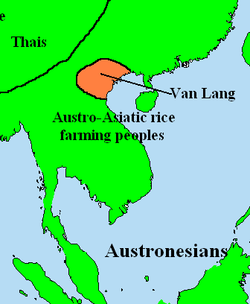Dinasti Hồng Bàng
Periode Hồng Bàng (bahasa Vietnam: thời kỳ Hồng Bàng),[2] juga disebut Dinasti Hồng Bàng,[3] merupakan periode semi mitologi legendaris dalam historiografi Vietnam, mulai dari awal pemerintahan Kinh Dương Vương hingga negara bagian Văn Lang (awalnya disebut Xích Quỷ) pada 2879 SM hingga penaklukkan negara oleh An Dương Vương pada 258 SM.[3]
Hồng Bàng 鴻龐 | |||||||
|---|---|---|---|---|---|---|---|
| skt. 2879 SM–258 SM | |||||||
 Map Văn Lang | |||||||
 | |||||||
| Status | Kerajaan | ||||||
| Ibu kota | Ngàn Hống (skt. 2879 SM – ?) Nghĩa Lĩnh (skt. abad ke-29 SM) Phong Châu (hingga 258 SM) | ||||||
| Bahasa yang umum digunakan | Vietnam kuno[1] | ||||||
| Agama | Animisme, agama rakyat | ||||||
| Pemerintahan | Monarki absolut | ||||||
| Raja | |||||||
• 2879–2794 SM | Hùng Vương I (pertama) | ||||||
• 408–258 BC | Hùng Vương XVIII (terakhir) | ||||||
| Era Sejarah | Sejarah kuno, Zaman Perunggu, Zaman Besi | ||||||
• Mendirikan konfederasi Xích Quỷ oleh Kinh Dương Vương | skt. 2879 SM | ||||||
• Ditaklukkan oleh Thục Phán | 258 SM | ||||||
| |||||||
| Sekarang bagian dari | Vietnam Tiongkok | ||||||

Tawarikh Vietnam abad ke-XV Đại Việt sử ký toàn thư (Sejarah Lengkap Đại Việt) menyatakan bahwa periode tersebut dimulai dengan Kinh Dương Vương sebagai Raja Hùng pertama (bahasa Vietnam: Hùng Vương), gelar yang digunakan dalam banyak diskusi modern tentang penguasa Vietnam kuno pada periode ini.[4] Raja Hùng adalah raja mutlak negara dan, setidaknya secara teori, memegang kendali penuh atas wilayah dan sumber dayanya. Đại Việt sử ký toàn thư juga mencatat bahwa ibu kota negara adalah Phong Châu di Tiongkok yang sekarang. Di sebelah timur berbatasan dengan Laut Timur, di barat dengan Ba Thục (sekarang Sichuan), di utara dengan Danau Dongting (Hunan), dan di selatan dengan Champa.
Lihat pula sunting
Referensi sunting
- ^ "Colonial Diasporas & Traditional Vietnamese Society". Diarsipkan dari versi asli tanggal 2013-10-03. Diakses tanggal 2021-07-06.
- ^ Dror, p. 33 & 254 "Hồng Bàng period"
- ^ a b Pelley, p. 151
- ^ Tucker, Oxford Encyclopedia of the Vietnam War
Sumber sunting
- Bayard, D. T. 1977. Phu Wiang pottery and the prehistory of Northeastern Thailand. MQRSEA 3:57–102.
- Dror, Olga (2007). Cult, Culture, and Authority: Princess Liẽu Hạnh in Vietnamese.
- Heekeren, H. R. van. 1972. The Stone Age of Indonesia. The Hague: Nijhoff.
- Hoang Xuan Chinh and Bui Van Tien 1980. The Dongson Culture and Cultural Centers in the Metal Age in Vietnam
- Kelley, Liam C. (2016), "Inventing Traditions in Fifteenth-century Vietnam", dalam Mair, Victor H.; Kelley, Liam C., Imperial China and its southern neighbours, Institute of Southeast Asian Studies, hlm. 161–193, ISBN 978-9-81462-055-0
- Lamb, David. Vietnam, Now: A Reporter Returns. PublicAffairs, 2008.
- Lévy, P. 1943. Recherches préhistoriques dans la région de Mlu Prei. PEFEO 30.
- Mourer, R. 1977. Laang Spean and the prehistory of Cambodia. MQRSEA 3:29–56.
- Ngô Văn Thạo (2005). Sổ tay báo cáo viên năm 2005. Hà Nội: Ban tư tưởng – văn hóa trung ương, Trung tâm thông tin công tác tư tưởng, 2005. 495 p. : col. ill.; 21 cm.
- Peacock, B. A. V. 1959. A short description of Malayan prehistoric pottery. AP 3 (2): 121–156.
- Pelley, Patricia M. Postcolonial Vietnam: New Histories of the National Past 2002.
- Phan Huy Lê, Trần Quốc Vượng, Hà Văn Tấn, Lương Ninh (1991), Lịch sử Việt Nam, volume 1.
- Sieveking, G. de G. 1954. Excavations at Gua Cha, Kelantan, 1954 (Part 1). FMJ I and II:75–138.
- Solheim II, W. G.
- 1959. Further notes on the Kalanay pottery complex in the Philippines. AP 3 (2): 157–166.
- 1964. The Archaeology of Central Philippines: A Study Chiefly of the Iron Age and its Relationships. Manila: Monograph of the National Institute of Science and Technology No. 10.
- 1968. The Batungan Cave sites, Masbate, Philippines, in Anthropology at the Eight Pacific Science Congress: 21–62, ed. W. G. Solheim II. Honolulu: Asian and Pacific Archaeology Series No. 2, Social Science Research Institute, University of Hawaii.
- 1970a. Prehistoric archaeology in eastern Mainland Southeast Asia and the Philippines. AP 13:47–58.
- 1970b. Northern Thailand, Southeast Asia, and world prehistory. AP 13:145–162.
- Tăng Dực Đào (1994). On the struggle for democracy in Vietnam.
- Tucker, Spencer C. Oxford Encyclopedia of the Vietnam War (hardback edition).
- Vuong Quan Hoang and Tran Tri Dung. Vietnam Entrepreneurial Cultures, The IUP J. Entrepreneurship Development, Vol. VI, No. 3&4, 2009.
- Zinoman, Peter (2001). The Colonial Bastille: A History of Imprisonment in Vietnam, 1862–1940. University of California Press. ISBN 9780520224124.
Kiernan, Ben (2019). Việt Nam: a history from earliest time to the present. Oxford University Press. ISBN 9780190053796.
Pranala luar sunting
- "Đồ đồng cổ Đông Sơn" [Đông Sơn ancient bronze tools] (dalam bahasa Vietnam). Diarsipkan dari versi asli tanggal 2009-04-30. Diakses tanggal 2022-02-16.
- "Ánh sáng mới trên một quá khứ lãng quên" [New Light on a Forgotten Past] (dalam bahasa Vietnam). Diarsipkan dari versi asli tanggal 2012-09-13.
| Didahului oleh: Penciptaan baru |
Dinasti Vietnam skt. 2879 – 258 SM |
Diteruskan oleh: An Dương Vương |
21°16′54″N 105°26′31″E / 21.28167°N 105.44194°EKoordinat: 21°16′54″N 105°26′31″E / 21.28167°N 105.44194°E


